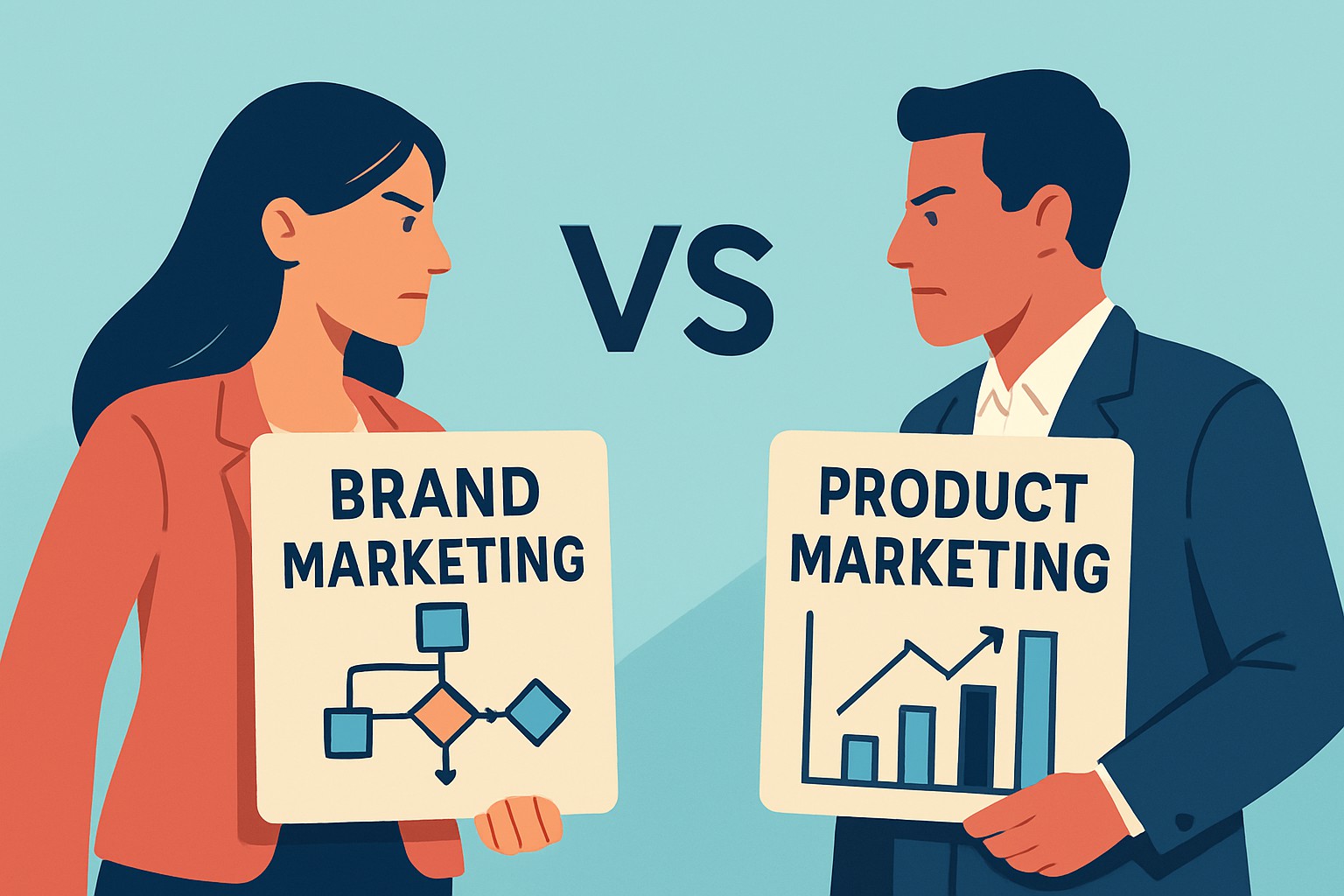
Best Content Marketing Strategies for the Finance Industry
Discover comprehensive strategies tailored for finance industry content marketing that build trust,...

Grasping the differences between brand vs product marketing is crucial for businesses aiming to sharpen their growth strategies. Each approach has its own unique role in shaping how customers perceive the company and in driving sales upward.
Brand marketing is all about building those lasting emotional connections and making a company’s identity stick in people’s minds, while product marketing zeroes in on spotlighting specific products and what makes them tick.
Brand marketing is all about crafting a company’s identity and values and building a meaningful emotional bond with its audience. Think of it as building trust and loyalty brick by brick for the long haul. Meanwhile, product marketing zooms in on the unique perks and advantages of specific products or services.
Brand marketing usually casts a wide net to shape how people perceive the company and forge an emotional connection with audiences that reflect the company’s core values and reputation. The goal is to build a strong identity and trust that last long after the product fades from the spotlight. On the flip side, product marketing gets more up close and personal by focusing on the actual users and buyers of a particular product. It showcases unique benefits and features and shows how the product solves problems for specific customer needs in defined niches.
| Aspect | Brand Marketing | Product Marketing |
|---|---|---|
| Audience Scope | Casts a wide net, aiming at broad demographics and general market segments | Zeroes in on specific buyer personas and niche users, really knowing its crowd |
| Messaging Focus | Tugs at the heartstrings by highlighting trust and core values | Keeps it practical, spotlighting benefits and diving into detailed features |
| Goal | Works to build brand awareness and nurture long-term loyalty, like planting seeds for the future | Sharpens its focus on driving conversions and encouraging active product use |
| Communication Style | Spins stories with a consistent brand voice that sticks in your mind | Gets straight to the point with direct, promotional, and sometimes technical language |
| Example | Moz’s reputation as a trusted SEO authority that’s stood the test of time | Moz Pro’s toolbox for keyword research and site audits, built for hands-on users |
| Engagement | Sparks a sense of community and emotional connection, making people feel part of something bigger | Highlights how product features fit specific needs, showing the practical side of things |
Marketing is not just a set of rigid rules; it is more like a toolbox filled with various approaches and methods, each suited to different gigs. Whether you are rolling up your sleeves for a grassroots campaign or diving into data-driven strategies, understanding these methods lets you play your cards right and connect with your audience in a way that feels genuine and effective.
Brand marketing strategies focus on crafting the company’s identity and spinning engaging stories that stick. They also ensure the brand voice stays consistent across the platform landscape. Meanwhile, product marketing takes a targeted route—think product launches that catch your eye and spotlight key features you can’t miss. It cleverly positions against competitors and rolls out campaigns that fire up demand and engage users with specific products or updates.
Success in brand marketing usually shows up in things like brand awareness and that all-important emotional connection as well as the steady climb in overall brand value. Product marketing tends to zero in on the nitty-gritty details such as conversion rates, sales volume and customer acquisition costs plus how quickly customers jump on board with the product.
| Metric | Brand Marketing | Product Marketing |
|---|---|---|
| Awareness | How well the brand sticks in people’s minds and gets recognized | How visible the product is when customers are scouting around |
| Emotional Sentiment | The vibe customers have about the brand and how loyal they feel | How happy customers are with the product itself |
| Equity | The brand’s value and reputation scores—basically its street cred | How the product is regarded within its target crowd |
| Conversion | Not really applicable here (usually a behind-the-scenes effect) | The rate at which individuals go from interested to actually buying or signing up |
| Sales Volume | Not applicable | The actual count of units sold and the money rolling in from the product |
| Acquisition Cost | Not applicable | What it costs to bring each new customer or product user on board |
| Engagement | How much buzz and interaction the brand gets on social media | The click-through rates on campaigns and how many take the plunge with a trial |
Brand marketing typically calls for a steady flow of budget to keep the reputation-building wheels turning—think PR, sponsorships and a constant stream of content creation. Meanwhile, product marketing budgets are often hit-and-run operations focused on particular projects such as launches, promotional events and direct response ads designed to spark immediate sales and get the product into customers’ hands.
Deciding between brand marketing and product marketing really boils down to your business goals, where your product sits in its lifecycle and what is happening in the market at the moment. Brand marketing is your trusty sidekick when you’re setting up shop or trying to polish your company’s reputation until it shines. Meanwhile, product marketing tends to steal the spotlight during product launches or updates, or whenever you’re zooming in on specific buyer needs.
Lean on brand marketing to shape or breathe new life into your corporate identity while slowly winning over customer trust—it's a marathon not a sprint.
When launching new products or introducing features that need user hand-holding, zero in on product marketing to educate and gently persuade.
Use product marketing as your secret weapon to connect with niche audiences or tackle specific customer pain points by tailoring your messages like a bespoke suit.
In crowded dog-eat-dog markets, let brand marketing do the heavy lifting by showcasing your values and experience—it's how you catch the eye without shouting.
Turn to product marketing to fine-tune your sales funnel and boost conversion and activation rates with campaigns that rely on good old data insight.
And lastly, don’t be shy about mixing brand and product marketing—it’s the magic combo that helps cultivate loyal customers for the long haul.
Successful companies often find a sweet spot where their brand and product marketing strategies work hand in hand, letting the brand story back up product messaging while product wins quietly build the brand’s reputation. This kind of integrated approach does more than create consistency. It boosts marketing effectiveness and delivers a smoother ride for customers.
"> Brand and product marketing really do go hand in hand. Without a solid brand backing you up, product marketing often misses the mark, and without products that truly deliver, those shiny brand promises can start to sound a bit hollow. Bringing the two together? That’s the secret sauce for steady, reliable growth—no shortcuts here. — Marketing Thought Leader"

Visual diagram illustrating the intersection and overlap between brand marketing and product marketing activities
When deciding between brand vs product marketing, remember that brand marketing aims to forge lasting emotional connections and build broad awareness that sticks around, while product marketing zeroes in on targeted tactical moves designed to give immediate sales and user engagement a nice jumpstart. Picking the right approach hinges on your business priorities and the stage you're at in the lifecycle.
| Category | Brand Marketing | Product Marketing | Winner / Tie |
|---|---|---|---|
| Focus | Building long-term brand value that sticks around | Driving short-term product sales that get the cash register ringing | Tie – really depends on what you’re aiming for |
| Audience | Broad and emotional, speaking to the heart | Targeted and rational, appealing to the head | Tie – it all varies with the context |
| Strategies | Storytelling and positioning that paint the big picture | Product launches, feature spotlights that grab immediate attention | Tie – honestly, they work best side by side |
| Metrics | Awareness and brand sentiment, because feelings count | Conversion rates and revenue, the bottom line that pays the bills | Product Marketing (edges out for ROI) |
| Budget | Ongoing investment, keeping the brand in the spotlight | Tactical, campaign-based bursts of spending | Tie – it really depends on the phase you’re in |
| Timing | Continuous and evergreen, like a well-tended garden | Centered around events, making a splash when it counts | Tie – the magic happens when they’re combined |
14 articles published
Driven by a passion for ethical marketing, Garrett Meadowlark has transformed the field with his unconventional yet highly effective methods that prioritize authenticity and transparency.
Read Pages
Discover comprehensive strategies tailored for finance industry content marketing that build trust,...

Explore the fundamentals of agile content marketing, why it’s essential in today’s marketing landsca...

Discover practical, step-by-step content marketing for events techniques that drive attendance, elev...

Unlock the power of high-performance content to engage audiences, improve SEO, increase conversions,...